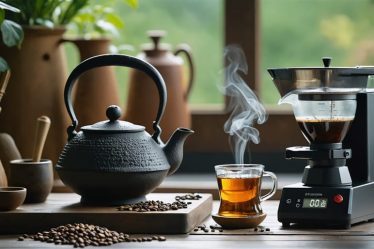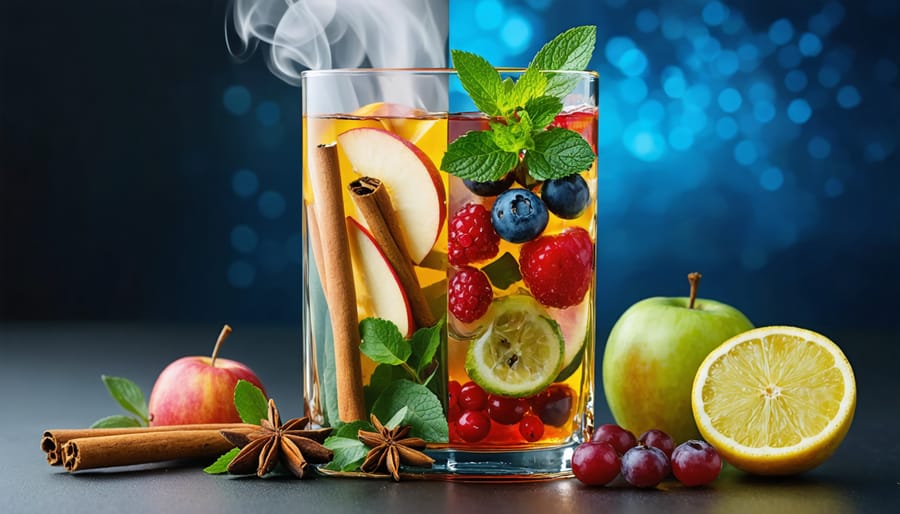
Transform ordinary drinks into captivating infused beverages by combining fresh herbs, fruits, or spices with your base liquid in a sealed container for 4-24 hours. Amid the rising popularity of artisanal beverages, home-crafted infusions offer a perfect blend of creativity and sophistication.
Start with classic combinations like cucumber-mint water or strawberry-basil lemonade, then experiment with unexpected pairings such as lavender-honey tea or rosemary-grapefruit sparkling water. The secret lies in selecting quality ingredients and allowing proper infusion time – delicate herbs need just a few hours, while harder fruits and spices benefit from overnight steeping.
Create your signature infused drinks by matching complementary flavors: citrus brightens herbal notes, while berries balance earthier elements like ginger or cardamom. Whether you’re elevating your daily hydration routine or preparing for elegant entertaining, infused beverages offer endless possibilities for personalizing your drink experience without artificial additives or excess sugar.
These versatile concoctions work beautifully as standalone refreshments, sophisticated cocktail mixers, or elegant alcohol-free alternatives that bring both visual appeal and complex flavor profiles to any occasion.
The Art and Science of Infusion
Cold vs. Hot Infusion Methods
The beauty of artisan beverage crafting lies in its versatility, and choosing between cold and hot infusion methods can dramatically impact your drink’s final flavor profile. I discovered this firsthand when experimenting with my favorite citrus-herb combinations!
Cold infusion is perfect for delicate ingredients like berries, herbs, and citrus fruits. By steeping these ingredients in room temperature or cold water for 4-12 hours, you’ll preserve their subtle nuances and avoid any bitter notes. This method works beautifully for creating refreshing summer drinks and is especially gentle on heat-sensitive ingredients like mint and cucumber.
Hot infusion, on the other hand, is your go-to method when you want to extract bold flavors quickly. Bringing your liquid to a simmer before adding ingredients like spices, dried fruits, or woody herbs will release their essential oils and complex flavors in just 5-10 minutes. I love using this method for warming winter beverages and when I’m working with heartier ingredients like cinnamon, ginger, or dried apple.
Remember, there’s no strict rule – feel free to experiment with both methods to find what works best for your favorite flavor combinations!
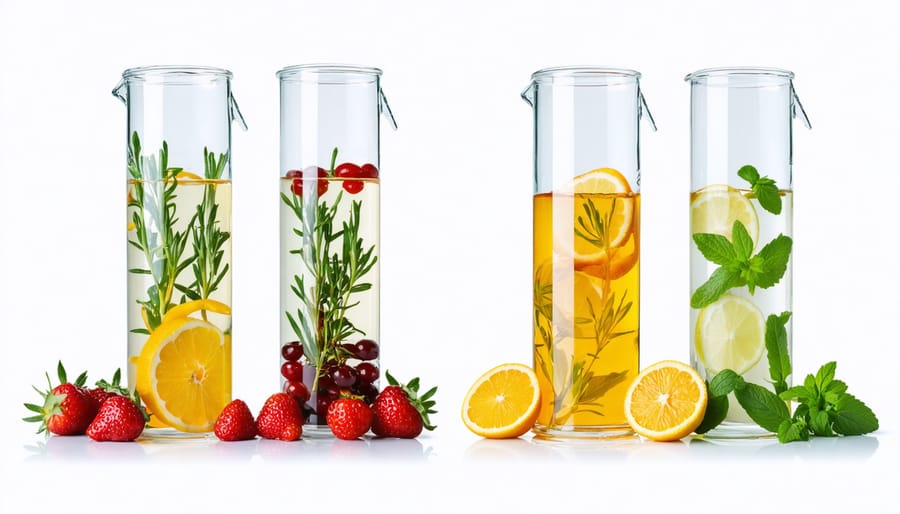
Choosing Your Base
The foundation of any great infusion starts with choosing the right base liquid – it’s like picking the perfect canvas for your masterpiece! I learned this the hard way when I first started experimenting with infusions, but now I’m excited to share what works best.
For light, refreshing infusions, water is your faithful friend. It lets the infused ingredients shine without competing flavors, making it perfect for delicate herbs and subtle fruit combinations. When I’m craving something with more character, I turn to white tea or green tea as a base – they add a gentle complexity that plays beautifully with florals and citrus.
For those cozy moments, consider using apple juice or coconut water as your base. They bring natural sweetness and depth while still allowing other flavors to come through. If you’re planning to use your infusion in cocktails, vodka or gin make excellent bases, though remember that alcohol will extract flavors more intensely than non-alcoholic options.
My personal favorite is sparkling water – it adds a festive touch to any infusion and makes everyday moments feel special. Just remember that whatever base you choose should complement, not overpower, your infusion ingredients.
Seasonal Infusion Ideas That Wow
Spring and Summer Infusions
When the weather warms up, there’s nothing quite like a light, garden-inspired infusion to elevate your hydration game. I love experimenting with refreshing summer drink combinations that capture the essence of the season, and these infusions have become my go-to choices for entertaining or simply enjoying a peaceful moment on the patio.
Start with fresh strawberries and basil for a classic springtime pairing that’s both sophisticated and approachable. The sweetness of ripe berries perfectly complements the herbaceous notes, creating a drink that’s as beautiful as it is delicious. For a tropical twist, try combining fresh pineapple chunks with sprigs of mint and a hint of lime – it’s like a vacation in a glass!
One of my favorite discoveries has been cucumber, lavender, and lemon infusion. The cucumber provides a cool, crisp base while lavender adds a subtle floral note that transforms ordinary water into something truly special. For those sunny afternoon gatherings, nothing beats a combination of juicy peaches, fresh thyme, and a splash of honey – it’s become my signature drink for summer brunches.
Remember to let these infusions steep for at least four hours, though overnight brings out the fullest flavors. I’ve found that using room temperature water initially, then chilling afterward, helps extract the most flavor from your ingredients while maintaining their vibrant colors.
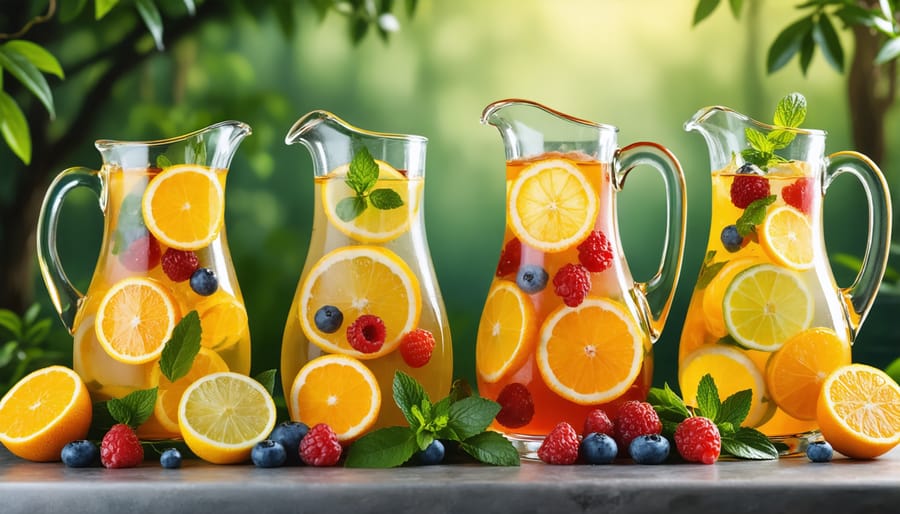
Fall and Winter Comfort
As the temperatures drop and leaves turn golden, our cravings naturally shift toward warmer, more comforting beverages. There’s something magical about wrapping your hands around a steaming mug of homemade infused goodness that instantly makes you feel cozy and content.
One of my favorite fall infusions combines fresh apple slices, cinnamon sticks, and star anise in hot water. Let it steep for about 10 minutes, and you’ll have a naturally sweet, spice-filled drink that captures autumn in a cup. For an extra touch of warmth, add a splash of maple syrup and a pinch of nutmeg.
Winter calls for deeper, richer flavors. Try infusing hot water with fresh ginger, orange peel, and cardamom pods. This warming combination not only tastes delicious but can help boost your immune system during cold and flu season. For a festive twist, add cranberries and rosemary sprigs – it’s both beautiful and beneficial.
Don’t forget about classic combinations like pear and vanilla bean, or dark cherry and cinnamon. These fruit-forward infusions can be enjoyed hot or warm, and they’re perfect for serving at holiday gatherings. I love setting up an infusion station during winter parties, letting guests customize their drinks with different fruit and spice combinations.
Remember, these warming infusions aren’t just drinks – they’re little moments of comfort that help make the cold seasons more enjoyable.
Essential Tools and Ingredients
Creating beautiful infusion beverages starts with having the right tools and ingredients in your kitchen. As someone who’s spent countless hours experimenting with different infusions, I can tell you that investing in quality basics makes all the difference. Along with your essential home bar tools, here’s everything you’ll need to start your infusion journey.
First, let’s talk containers. You’ll want at least two large glass mason jars with tight-fitting lids – these are perfect for both infusing and storing your creations. A fine-mesh strainer and cheesecloth are must-haves for filtering out solid ingredients, ensuring your final beverage is smooth and clear.
For measuring and preparing ingredients, gather these basics:
– Digital kitchen scale
– Measuring cups and spoons
– Sharp knife and cutting board
– Vegetable peeler
– Clean bottles for storing finished infusions
As for ingredients, start with a good base spirit or liquid. Vodka is perfect for beginners due to its neutral flavor, while white rum and gin can add interesting dimensions. For non-alcoholic infusions, filtered water, white tea, or coconut water make excellent bases.
Keep these pantry staples on hand:
– Fresh fruits (berries, citrus, stone fruits)
– Herbs (mint, basil, rosemary)
– Spices (cinnamon, vanilla beans, peppercorns)
– Natural sweeteners (honey, agave nectar)
Remember to choose organic produce when possible, as pesticides can affect the infusion’s flavor. And always keep extra citrus fruits around – they’re wonderful for adding brightness to almost any infusion combination.
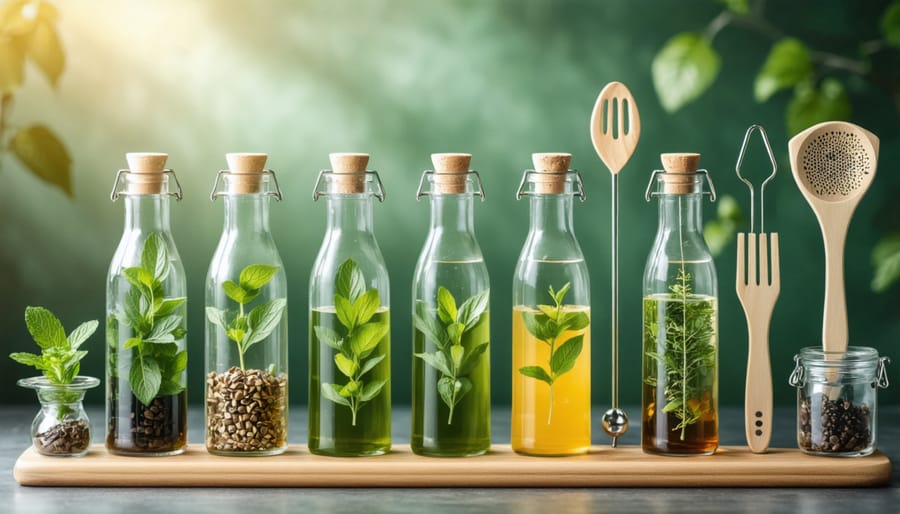
Troubleshooting Your Infusions
Let’s face it – even the most experienced home mixologists encounter a few hiccups when creating infused beverages. I remember my first attempt at a cucumber-mint infusion that turned cloudy and bitter – definitely not the refreshing drink I had envisioned! But don’t worry; these common challenges all have simple solutions.
If your infusion tastes too weak, you’re probably not using enough ingredients or letting them steep long enough. A good rule of thumb is to fill about one-third of your container with fresh ingredients and allow at least 4-6 hours for subtle flavors and up to 24 hours for stronger ones.
Dealing with cloudy infusions? This usually happens when you’ve muddled or crushed your ingredients too aggressively. Instead, try gentler handling and strain your infusion through a fine-mesh strainer or cheesecloth. For crystal-clear results, you might need to strain it twice.
Brown or discolored fruits in your infusion can be disappointing, but it’s usually just natural oxidation. To prevent this, try adding a splash of lemon juice to your mix, which helps preserve the natural colors. Also, keep your infusions refrigerated and away from direct sunlight.
If you’re experiencing unwanted bitterness, you’ve likely left your ingredients steeping too long. Citrus peels, herbs, and spices can become overwhelming if left too long. Start tasting your infusion every few hours to find the perfect flavor balance.
For those finding their infusions aren’t as flavorful as expected, temperature plays a crucial role. Room temperature infusions work well for most ingredients, but some fruits and herbs release their flavors better in slightly warmer conditions. Just avoid hot temperatures, which can cook your ingredients and alter their taste.
Remember, creating perfect infusions takes practice and patience. Keep notes on what works (and what doesn’t), and don’t be afraid to experiment with different combinations and techniques. Soon enough, you’ll be crafting Instagram-worthy infusions like a pro!
The beauty of infusion beverages lies in their endless possibilities for creativity and personal expression. As you’ve discovered throughout this guide, creating these delightful drinks is more art than science, and there’s no better way to perfect your craft than by experimenting with different combinations and techniques.
Don’t be afraid to venture beyond traditional recipes and trust your instincts. Perhaps you’ll discover that lavender pairs wonderfully with your morning tea, or that cucumber and mint create the perfect afternoon refresher. Your kitchen can become a laboratory of flavors, where each infusion tells its own unique story.
Remember that some of the most memorable drinks come from happy accidents and bold experiments. Start with our suggested combinations, but feel free to adjust ratios and ingredients to match your taste preferences. Keep a small journal of your creations – note what works, what doesn’t, and what surprises you along the way.
Share your creations with friends and family, gather their feedback, and let their reactions guide your next infusion adventure. Before you know it, you’ll have developed your own signature drinks that reflect your personal style and taste. Happy infusing!



